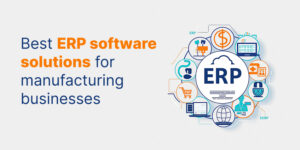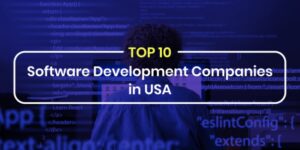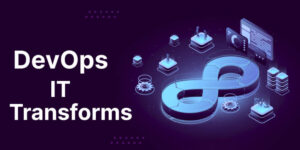
The enterprise software landscape is undergoing a rapid transformation. These tools are designed to help business owners reshape their businesses. They help businesses in numerous ways, from handling operations to making decisions and delivering value. Enterprise software has evolved beyond a mere backend function. It now serves as a strategic enabler that drives innovation, resilience, and growth. In 2025, companies that embrace these shifts are finding themselves better positioned to thrive in a hyper-dynamic global economy.
Gone are the days of disconnected software silos. Enterprises are channelling resources into platforms that integrate various systems, such as sales, finance, HR, supply chain, and so on, into a unified digital ecosystem. Companies are now making use of seamless APIs and advanced middleware to transform workflows and enhance speed, intelligence, and intuitiveness. If you plan to have it all with an Enterprise software, then read this post for the 10 best Enterprise software Development trends in 2025. Let’s get started…
Table of Content
- Top 10 Enterprise Software Trends for 2025
- AI-Driven Automation Becomes Standard
- Rise of Industry-Specific Cloud Platforms
- Composability and Modular Software Architecture
- AI-Enhanced Cybersecurity
- Low-Code/No-Code Mobile App Development
- Enterprise Mobile App Development
- Game Development (Mobile)
- Unified Data Fabric and Integration Platforms
- Sustainability Tracking and ESG Reporting Tools
- Decentralized Identity and Web3 Integration
- Key Considerations for Adopting Modern Enterprise Software
- Consider Your Business Objectives
- Understand the Total Cost of Ownership
- Ensure Seamless Integration
- Focus on User Adoption and Training
- Prioritize Data Security and Governance
- Choose the Right Vendor
- Plan for Scalability and Flexibility
- Have a Balance of Configurability and Customizability
- Demand Analytics and ROI Measurement
- Future-Proof Your Investment
- The Bottom Line
Top 10 Enterprise Software Development Trends for 2025
Here is our rundown of some of the top enterprise software Development trends making an impact in 2025, which are bound to excite businesses in the years to come. Take a look…
1. AI-Driven Automation Becomes Standard
AI, or Artificial Intelligence, is no longer a futuristic concept. It has, in fact, become a foundational element in enterprise software. Companies are embedding AI capabilities into core systems to enhance performance and make smarter decisions. Whether it’s through predictive analytics that forecast market trends, generative AI chatbots providing 24/7 customer service, AI-powered reverse image search tools providing effective research, or intelligent document processing that eliminates manual data entry, automation is becoming the norm. AI-driven features not only cut costs, but they also improve accuracy. Additionally, they free up human capital to a larger extent and help businesses respond faster to market changes.
Let’s understand this with an example:
AI chatbots in customer service can handle thousands of queries simultaneously, which is nearly impossible for humans to do. It significantly reduces the burden on human agents. In similar lines, predictive tools in supply chain management help anticipate inventory needs, which thereby help prevent overstocking or shortages. As AI matures, its applications will expand, pushing enterprises toward more proactive and intelligent operations.
2. Rise of Industry-Specific Cloud Platforms

Then, there is a notable increase in the industry-specific cloud platforms. Yes, generic cloud solutions are being replaced by vertical cloud platforms. These platforms are specifically designed for specific industries like healthcare, finance, manufacturing, and retail. These sector-focused solutions come equipped with built-in compliance features, industry-relevant templates, and specialized analytics tools. This, in turn, helps businesses accelerate deployment, reduce the need for heavy customization, and meet regulatory requirements more easily.
Here are the examples for you:
A cloud platform tailored for healthcare includes HIPAA-compliant data handling and patient scheduling modules. Financial firms can make use of platforms pre-equipped with anti-fraud analytics and real-time transaction monitoring. Whatever the case, these tailored solutions provide faster time-to-value and significantly reduce the risk of compliance violations.
3. Composability and Modular Software Architecture
Then comes composability and modular software architecture. Conventional monolithic software systems have become inflexible as they were always hard to adapt to. Composable platforms, on the other hand, allow businesses to choose and assemble interoperable components. Some of the major components include CRM, finance, procurement, and HR. These can be assembled into a tech stack fitting users’ unique needs. This modular architecture supports rapid changes. Whether it’s launching a new product, entering a new market, or responding to disruptions, Composable platforms come in handy.
Let’s understand it with an example:
Composable platforms are like building with LEGO blocks. Instead of a single, rigid structure, you can rearrange and expand your tech stack as your business evolves. This approach increases agility, reduces implementation time, and makes innovation more scalable across departments.
4. AI-Enhanced Cybersecurity

The next Enterprise software Development trend that has seen a significant surge in the past few years is AI in Cybersecurity. With cyber threats growing more complex, enterprises are moving beyond traditional security measures. Now they are embracing AI-powered platforms for data protection. The best thing about these systems is that they can detect anomalies in real-time. Additionally, they are able to assess user behavior patterns and automate responses to cyber threats like ransomware or phishing attacks. Behavioral analytics helps identify suspicious activity before it gets severe.
Here is an example:
If an employee’s account suddenly accesses large volumes of sensitive data at odd hours, the system will immediately flag or even block the activity automatically. AI in Cybersecurity offers a higher level of proactive security. This significantly minimizes response time and reduces the damage caused by breaches.
5. Sovereign Cloud and Data Localization
Data privacy laws are becoming strict throughout the world. Now, it has become crucial for businesses and organizations of all levels to comply with region-specific regulations. In such a situation, Beyond just data storage, this trend is part of a broader push towards comprehensive software localization. To truly succeed in these sovereign markets, it’s not enough to store data locally; the software’s user interface, content, and workflows must also be adapted to meet local language and cultural expectations. A software localization guide can provide a nice framework for navigating these requirements.
Here is an example:
The EU’s General Data Protection Regulation (GDPR) is the best example of data sovereignty in action. Aside from that, India also has data localization requirements for financial and healthcare data. According to which data should only be stored within the country. Sovereign Cloud and Data Localization help ensure compliance with rules like the EU’s GDPR or India’s Data Protection Bill. Moreover, sovereign cloud solutions also provide enhanced encryption and access controls. This gives organizations greater confidence in how their data is stored and used.
6. Low-Code/No-Code Expansion
Then there are Low-code and No-code platforms. These platforms are transforming software development trends by allowing non-developers, often referred to as “citizen developers,” to create applications and streamline workflows. These platforms feature drag-and-drop interfaces, prebuilt templates, and visual logic builders. This makes development accessible to business users. All in all, these platforms empower departments like marketing, HR, or operations to build their own tools. This, in turn, reduces the workload on IT teams and speeds up innovation.
Here is an example:
A marketing manager in a company can create a campaign tracking dashboard using Low-code/No-code platforms. The best thing is he doesn’t have to wait for the IT guy to help him. This shift not only accelerates digital transformation but also fosters a culture of innovation across the organization.
7. Predictive and Prescriptive Analytics
Another Enterprise software development trend that has gained immense traction in the past few years is the use of Analytics tools. Analytics tools have evolved from backward-looking dashboards to forward-looking systems. These tools now provide actionable insights. The most common Analytics tools include Predictive and Prescriptive Analytics. Predictive analytics tools are used for predicting future trends. They forecast trends based on historical data. On the other hand, prescriptive analytics are used for getting recommendations so that specific actions can be taken to achieve desired outcomes.
Let’s understand this with an example:
A predictive model is a great tool for retail companies. They can use it to anticipate customer demand during peak seasons and adjust their inventories accordingly. Prescriptive tools, on the other hand, can be used for designing optimal pricing strategies or marketing campaigns. These AI-driven insights help businesses make smarter, faster decisions and stand out amidst competition.
8. Unified Data Fabric and Integration Platforms
Enterprises at all levels are struggling with data sprawl across hybrid and multi-cloud environments. Unified data architectures, also called data fabrics, come in handy in such a situation. They are designed to address the issue of data sprawl. They do it by connecting disparate data sources and enabling consistent access, governance, and analytics.
Here is an example:
Instead of data being trapped in silos across departments or platforms, a unified fabric is utilized. It ensures real-time visibility and seamless integration. This empowers leaders to make data-driven decisions based on a complete and current picture of the organization. Unified platforms also support compliance and security by standardizing data access policies.
9. Sustainability Tracking and ESG Reporting Tools
Sustainability is no longer a peripheral concern. In fact, it has now become a boardroom priority for businesses of all levels. In order to facilitate ESG (environmental, social, and governance) reporting, enterprise software is undergoing a transformation. It involves integrating sustainability analytics into fundamental computing platforms. These tools track metrics like energy consumption, carbon emissions, labor practices, and corporate governance. Moreover, automated ESG reporting helps businesses meet regulatory requirements, respond to investor expectations and build trust with consumers.
Here is an example for it:
A manufacturer is using IoT-enabled tools to monitor emissions in real time and feed that data into ESG dashboards. Such a level of transparency allows organizations to align operations with sustainability goals and demonstrate accountability.
10. Decentralized Identity and Web3 Integration
Last but not least is Decentralized Identity and Web3 Integration. This is in fact the latest Enterprise software development trend; however, it is still emerging. Blockchain technology has just begun to influence enterprise software. This technology is particularly used in areas like identity management, smart contracts, and decentralized applications (dApps). These tools are actually making waves in industries like finance and supply chain. They help improve transparency, security, and operational efficiency.
Here is an example:
Decentralized identity systems allow users to own and control their credentials. This significantly reduces the chances of fraud and simplifies the verification process. Smart contracts can automate agreements, triggering actions when conditions are met, such as releasing payment when goods are delivered. With more and more companies utilizing these tools, they will provide effective solutions to data integrity issues.
So, these are the top 10 enterprise software development trends that have gained traction. Let’s now take a look at key considerations to make a mindful choice of enterprise software. Here we go…
Key Considerations for Adopting Modern Enterprise Software
Of course, there are several new trends out there in the market. However, it is worth noting that not every new tool will suit every business. It is vital for companies to be thoughtful when choosing an enterprise software for their needs. They need to ponder what, when, and how they adopt new software development solutions prior to making a decision. Here are some of the important factors to evaluate before choosing a tool, take a look…
1. Consider Your Business Objectives

There is no point in adopting technology for the sake of trendiness. It can be a risky move. Before you invest in any platform, be it AI, low-code, or blockchain, you must ask yourself these three questions:
- Does this help us achieve our goals?
- Will it improve customer experience, increase efficiency?
- Will it drive business growth?
Once you get answers to these questions, it becomes easy to make a choice. Invest in a solution that directly supports your strategic vision.
2. Understand the Total Cost of Ownership
Every software solution is priced differently depending on its features and uses. It is crucial to understand the total cost of ownership, also known as TCO, prior to buy a solution. This is because subscription pricing models often appear budget-friendly; however, you need to be wary of hidden costs that change the whole game. Consider every expense, including expenses for integration, customization, employee training, and system downtime. A true TCO analysis provides a realistic view of what the software will cost over time and whether it’s worth it or not.
3. Ensure Seamless Integration

It is crucial to ensure seamless integration, as some tools can be really tricky, especially if you wish to integrate them into existing systems. For instance, if you wish to invest in a new CRM system, make sure it syncs with your other systems as well. Otherwise, you may face inefficiencies and data silos. Make sure to prioritize solutions that offer robust APIs, along with middleware support, and proven compatibility with your current infrastructure.
4. Focus on User Adoption and Training
User adoption and training are yet other important aspects to consider when buying an enterprise solution. Know that even the most powerful tool becomes useless if employees cannot use it or avoid using it. Therefore, it is crucial to look for a system with a strong onboarding experience, an intuitive interface, and ongoing training resources. This will help users to embrace the new system, and you will be able to see better results and faster ROI.
5. Prioritize Data Security and Governance
In this era, protecting data has become crucial. With the increase in cloud-based and AI-driven tools, it has become crucial to protect sensitive data. As an organization, you must implement strict data governance policies, enforce role-based access controls, encrypt sensitive data, and monitor activity in real-time to ensure compliance and security.
6. Choose the Right Vendor
Choosing the right partner is crucial to have a peaceful integration and operation. Therefore, it is crucial to evaluate vendors very carefully. Don’t just make a decision based on product features. Look for the support quality, update frequency, financial health, and long-term roadmap. Remember that a reliable partner will not only grow with you but also support your evolving needs.
7. Plan for Scalability and Flexibility
The main attraction of this era is the fast change. Nothing remains the same, not even your business. Hence, invest in an enterprise software that is capable of adapting to changes as you grow, expand into new markets, or shift your workforce model. Look for platforms that can easily be scaled and offer modular upgrades or integrations. Doing so will allow you to evolve without spending anything extra on your solution.
8. Have a Balance of Configurability and Customizability
Look for a solution that is both configurable and customizable. This is because highly customizable solutions may sound attractive but can become difficult to manage. At the same time, configurable platforms offer faster implementation but might limit customizability, hindering further growth. The balance of these two can turn out to be the best solution for any organization.
9. Demand Analytics and ROI Measurement
Know that the software you buy should deliver insights, not just functionality. Hence, look for solutions that include built-in analytics and performance dashboards. This will allow you to track ROI, forecast trends, and measure KPIs in real time.
10. Future-Proof Your Investment
Lastly, make sure you invest in a solution that is future-proof. Remember that technology evolves faster than you can imagine. Investing in a future-proof solution will help you avoid getting stuck with outdated tools. It is wise to invest in a tool that is built on open standards and adaptable architecture. Additionally, future-proof platforms are designed to support next-gen capabilities like AI integrations, IoT devices, or edge computing. All these ensure longevity and relevance.
The Bottom Line
So, this is all about the latest enterprise software development trends in 2025. In 2025, enterprise software transcends mere operational infrastructure. It serves as a catalyst for agility, insight, and growth. The modern business landscape is being transformed by intelligent automation, industry-specific platforms, and decentralised identity systems, making tools more intelligent, rapid, and interconnected than at any previous time.
However, it is worth noting that the technology is only powerful when you use it strategically. Businesses who carefully evaluate tools, keeping their goals in mind are sure to succeed in the long run. Remember that the right enterprise software can become a launchpad for sustainable, scalable success. Hence, be wise when choosing one!
Let’s now take a look at the FAQs pertaining to enterprise software development trends in 2025. Here we go…
FAQs
1. Why are enterprise software development trends important for businesses in 2025?
Technology keeps changing. Utilizing advanced technology ensures enhanced operations and improved ROI. Investing in the right technology can help you redefine the way your business operates and have a competitive edge. Additionally, it can help you make decisions and offer a unique customer experience.
2. How are modern tools changing traditional workflows?
Now is the time to have integrated platforms. These platforms help automate tasks, improve collaboration, and deliver real-time insights. Moreover, they allow organizations to respond to change more effectively and efficiently.
3. What makes composable software better than traditional systems?
Composable platforms are better than traditional systems in various ways. However, the most notable one is that they allow companies to build modular, scalable systems that evolve with their needs. This helps businesses have greater flexibility and faster innovation compared to conventional systems that are known to be rigid.
4. Is AI in enterprise software just a passing trend?
No, not at all! AI is now in the mainstream. It supports automation, analytics, personalization, and more, which makes it a long-term strategic investment. Also, it has a great future ahead!
5. Why is UX so important in enterprise software?
User experience or UX is important in enterprise software as it boosts adoption, reduces training time, and improves productivity. A good UX will ensure that software integrates seamlessly into day-to-day operations.






